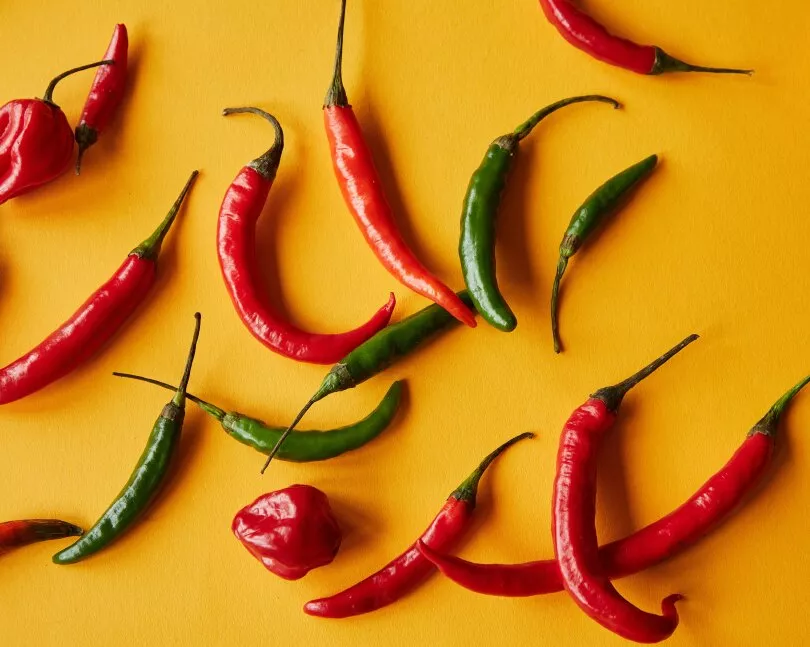Elements, Compounds And Mixtures
This article is going to cover the following learning outcomes:
- Define an element, a compound, and a mixture.
- State the chemical symbols of elements.
- Describe the differences between elements and compounds.
- Deduce the formula of a compound from the ratio of elements present.
- Describe the differences between compounds and mixtures.
This article is written to meet the requirements of Secondary 3 Chemistry students.
Elements
What is an element?
An element is a pure substance that cannot be broken down into two or more simple substances by chemical processes.
- The chemical processes can be:
- Thermal Decomposition: It involves heating the substance strongly until it decomposes or breaks down into smaller substances.
- Electrolysis: It involves using electricity to break down a compound.
- Example: When sugar is heated continuously, it breaks down into a black solid substance (carbon) and water vapour. Hence, sugar is not an element.
\(\text{Sugar } \xrightarrow[\qquad\qquad]{} \text{ Carbon + Water vapour}\)
Elements can be represented using chemical symbols, in which each chemical symbol may consist of either one or two letters. If the chemical symbol consists of only one letter, then that letter has to be capitalised. On the other hand, if the chemical symbol consists of two letters, then only the first letter is capitalised.
| Element | Symbol |
|---|---|
| hydrogen | H |
| helium | He |
| potassium | K |
| calcium | Ca |
| chlorine | Cl |
| Element | Symbol |
|---|---|
| copper | Cu |
| iron | Fe |
| lead | Pb |
| silver | Ag |
| tin | Sn |
Elements can be classified into their metallic and non-metallic properties.
The table below describes the general properties of metallic elements and non-metallic elements.
| Metals | Non-Metals |
|---|---|
|
|
In a Periodic Table, elements on the left of the zigzag (or staircase) line are metals, while elements on the right of the line are non-metals.
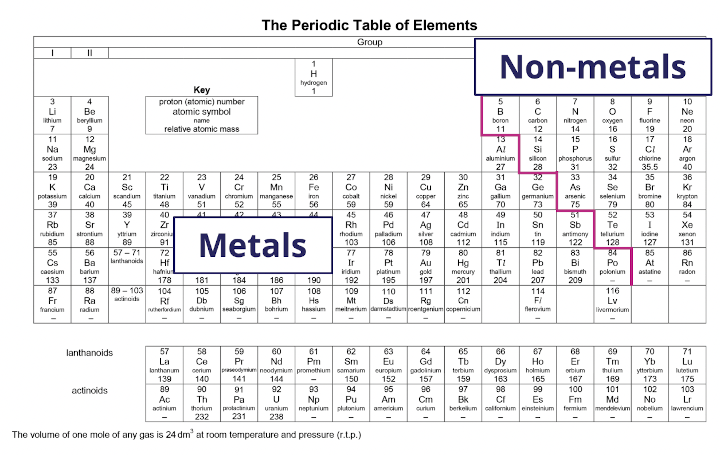
Elements which are found immediately adjacent to the line are the metalloids. For example, boron, silicon, germanium, arsenic, antimony, and tellurium are metalloids. They have properties that are between that of metals and non-metals.
Atoms and Molecules
Elements can exist as atoms or molecules.
Atoms are the smallest particles of an element that have the chemical properties of that element.
Each element is made up of only one type of atom.
Monatomic Elements
Monatomic elements are elements that exist as individual atoms. Elements in Group 0 of the Periodic Table are known as noble gases and they are made up of single atoms.
Examples:

Molecules
A molecule is a group of two or more atoms that are chemically combined together.
- Diatomic molecules are those that are formed by the combination of two atoms.
Examples:

A hydrogen molecule contains two hydrogen atoms that are chemically combined together. Hence, the molecular formula of hydrogen is H2. The subscript ‘2’ after the chemical symbol indicates that there are two hydrogen atoms chemically combined.
- Polyatomic molecules are those that are formed by the combination of three or more atoms.
Examples:

A molecule of ozone contains three atoms of oxygen chemically combined together. Hence, the molecular formula of ozone is O3.
Compounds
What is a compound?
A compound is a pure substance that contains two or more elements that are chemically combined in a fixed ratio.
The table below shows the ratio of the different elements that make up some of the common compounds.
| Compound | Chemical Formula | Ratio Of Atoms |
|---|---|---|
| hydrogen chloride | \(\text{HCl}\) | \(\begin{align} \mathrm{H} &: \mathrm{Cl}\\ \mathrm{1} &: \mathrm{1} \end{align}\) |
| carbon monoxide | \(\text{CO}\) | \(\begin{align} \mathrm{C} &: \mathrm{O}\\ \mathrm{1} &: \mathrm{1} \end{align}\) |
| nitrogen dioxide | \(\mathrm{NO_2}\) | \(\begin{align} \mathrm{N} &: \mathrm{O}\\ \mathrm{1} &: \mathrm{2} \end{align}\) |
| nitric acid | \(\mathrm{HNO_3}\) | \(\begin{align} \mathrm{H} &: \mathrm{N} \,: \mathrm{O}\\ \mathrm{1} &: \,\mathrm{1} \,: \,\mathrm{3} \end{align}\) |
| methane | \(\mathrm{CH_4}\) | \(\begin{align} \mathrm{C} &: \mathrm{H}\\ \mathrm{1} &: \mathrm{4} \end{align}\) |
Take carbon monoxide as an example. It is made up of two elements – carbon and oxygen. The ratio of carbon atom to oxygen atom in carbon monoxide is always 1 : 1. Changing this ratio will give a different compound. For instance, adding one more oxygen atom gives a ratio of 1 : 2 and the compound carbon dioxide.
Difference between elements and compounds
A compound has different properties from the elements that form it.

Decomposition of Compounds
To break down a compound into its constituent elements, thermal decomposition and electrolysis can be used.
Example:
As seen in the diagram, mercury(II) oxide is heated strongly. It decomposes to form the elements: mercury and oxygen gas.

Question 1 :
Which of the following statements is true for all compounds?
- Compounds are made up of two of the same atoms chemically combined together.
- Compounds are made up of two or more elements chemically joined together.
- Compounds are only formed in reactions involving three or more different elements.
- Compounds do not decompose into simpler substances when heated strongly.
Answer :
(B) Compounds are made up of two or more elements chemically joined together.
Explanation:
When two of the same atoms are chemically combined together, we get molecules of an element, not a compound.
Compounds can be broken down into simpler substances by chemical processes, such as thermal decomposition or electrolysis.
Mixtures
A mixture is made up of two or more substances that are not chemically combined.
The components of a mixture are not fixed. They can be in any ratio, unlike in a compound.
Seawater
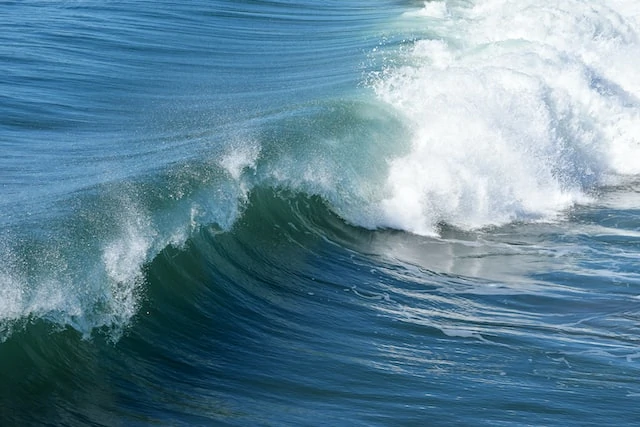
Image Credit: Pamela Heckel - unsplash.com
Air

Image Credit: Pero Kalimero - unsplash.com
Seawater and air are some examples of mixtures.
- Seawater is a mixture of salt, water, sand, and other impurities.
- Air is a mixture of different gases such as nitrogen gas, oxygen gas, carbon dioxide, water vapour, and argon.
A mixture can consist of either:
-
Elements only
Note: In Chemistry, atoms of different elements can be represented by different colours or sizes.
The blue circle in the picture represents the helium atom, which is a monatomic element. The white circles represent the oxygen gas molecules. Helium and oxygen form a mixture of elements.

Alloy is another example of a mixture of elements. An alloy consists of a metal with other elements. Steel, which is an alloy, is a mixture of iron and carbon.
-
Compounds only
Both carbon dioxide and water are compounds. They are not chemically combined together. Hence, it is a mixture.

Other mixtures of compounds include petrol, sugar solution, and salt solution.
-
Both elements and compounds
In the picture below, we have a mixture of oxygen (which is an element) and water (which is a compound). They are not chemically combined together, therefore, this is a mixture of an element and a compound.
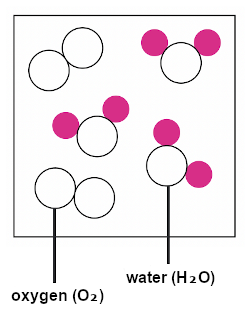
Another example of a mixture of elements and compounds is air. It is made of oxygen, argon, and nitrogen (which are elements) as well as carbon dioxide and water vapour (which are compounds).
Difference between Compound and Mixture
-
Separation
Compound
A compound can only be broken down into its elements or simpler components by chemical processes.
Mixture
The components of a mixture can be separated by physical processes, such as filtration, distillation, crystallisation etc.
-
Properties
Compound
The physical and chemical properties of a compound are different from those of its constituent elements.
Mixture
The physical and chemical properties of a mixture are the same as those of its components.
-
Energy Changes
Compound
A chemical reaction takes place when a compound is formed.
Mixture
No chemical reaction takes place when a mixture is formed.
-
Composition
Compound
The elements in a compound are always combined in a fixed proportion.
Mixture
The components of a mixture can be mixed in any proportion.
Question 2:
What does the diagram below show?
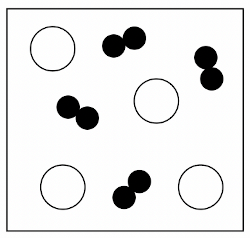
- a mixture of an element and a compound
- a mixture of three different atoms
- a mixture of two different elements
- a mixture of two different molecules
Answer :
(C) a mixture of two different elements
Explanation :
Each element is made up of only one type of atom.
The two black circles chemically combined together represent a molecule of an element.
The white circle represents an atom of another element.
These two different elements are not chemically combined with each other, hence, they form a mixture.
Question 3 :
Dry ice is obtained by freezing carbon dioxide at -78.5ºC. What will the dry ice contain?
- carbon atoms and oxygen ions
- carbon atoms and oxygen molecules
- carbon dioxide molecules only
- carbon molecules and oxygen molecules
Answer :
(C) carbon dioxide molecules only
Explanation :
Carbon dioxide is a compound made up of a carbon atom and two oxygen atoms chemically combined together.
Question 4 :
Which of the following observations suggests that an unknown substance cannot be an element?
- It has a fixed boiling point.
- It dissolves in water to form a pale-yellow solution.
- When heated, a brown solid and a yellow gas are formed.
- When heated in the air, oxides with two different chemical formulae are formed.
Answer :
(C) When heated, a brown solid and a yellow gas are formed.
Explanation :
An element cannot be broken down into simpler substances by chemical processes such as heating (thermal decomposition).
Question 5 :
Which of the following sets of substances consists of an element, a compound, and a mixture?
- air, bromine, steel
- brass, rust, sulfuric acid
- diamond, sugar, petrol
- methane, water, carbon dioxide
Answer:
(C) diamond, sugar, petrol
Explanation :
In option A, air and steel are mixtures, while bromine is an element.
In option B, brass is a mixture, while rust (which is iron(III) oxide) and sulfuric acid are compounds.
In option C, diamond is an element (made of carbon atoms only), sugar is a compound, and petrol is a mixture.
In option D, methane, water and carbon dioxide are all compounds.
Conclusion
In this article, we have learned what elements, compounds, and mixtures are, as well as the differences between them. All the learning outcomes have been discussed keeping in mind the Secondary 3 Chemistry syllabus. Daily practice and regular revision can help students get a strong hold on this chemistry topic.


 SG
SG  VN
VN 


